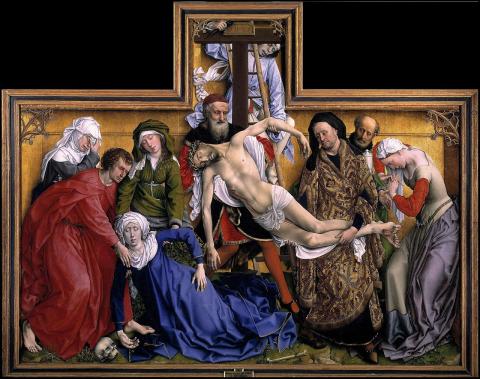Rogier van der Weyden created this work, entitled "Deposition" (also known as "Descent from the Cross"), circa 1435.
The oil-on-oak panel, which measures 220 x 262 cm (86.61 x 103.15 inches), imagines how the body of Jesus may have appeared after his death and before his burial. It is currently owned by the Prado Museum in Madrid.
Curators at the Prado tell us more about the work, including the individuals depicted in the painting:
The great master of Tournai [that is, van der Weyden] centers his composition on the Compassio Mariae, the passion felt by the Virgin at the suffering and death of her Son. In order to depict this, the painter chose the moment when Joseph of Arimathea, Nicodemus and a helper hold Jesus’ body in the air and Mary falls to the ground in a faint, where she is held by Saint John and the holy women.
The sumptuous materials—the blue of Mary’s robes is one of the purest lapis lazulis found in Flemish painting from that period—and large dimensions, with almost life-size figures, mark this work as exceptional. The shallow, gilded wooden space in which Weyden depicts his figures, and the tracery painted in the upper corners—which also imitates gilded wood—as well as the rectangular extension that tops the center, make these figures look like polychromed sculptures. Moreover, this visual trickery is further strengthened by the strong plastic sense with which Weyden’s figures are endowed. Here, as in all his early works, he follows the example of his teacher, Robert Campin.
Weyden masterfully handles the figures depicted in a limited background space and at the edges, where the opposing and complementary movements of Saint John and Mary Magdalene close the composition. Within this space, an outstanding play of parallel diagonals—in the form of Christ and Mary’s bodies—brings out their double passion. The expressions are striking, as is the contention with which feelings are expressed, and the play of curves and counter-curves that link the figures.
This work was commissioned by the Cross-bowmen’s Brotherhood of Louvain, now in Belgium, for their chapel at the Church of Nuestra Señora de Extramuros. Small crossbows are depicted at the lower corners of this work. It was acquired by María de Hungría in the sixteenth century and passed down to her nephew, Felipe II, who placed it in the chapel at the El Pardo Palace. In 1574, it was moved to El Escorial, where it remained until it was brought to the Prado Museum in 1939 in exchange for the copy by Michel Coxie.
Click on the image for a better view.
Media Credits
Image, described above, online courtesy Wikimedia Commons.
PD


